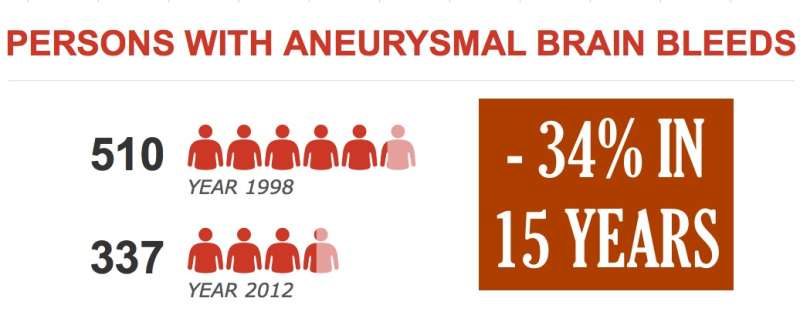Incidence of most fatal type of stroke decreasing—thanks to a decrease in smoking?

A new study indicates that Finland's national tobacco policies seem to be radically reducing the incidence of subarachnoid haemorrhage, the most fatal form of stroke.
Previously it was thought that in Finland approximately a thousand people suffer subarachnoid haemorrhage (SAH) every year - most of them adults of working age. Up to half of those afflicted die within a year. Subarachnoid haemorrhage is typically caused by a ruptured cerebral aneurysm, which leads to a sudden increase in the intracranial pressure. Smoking is a key risk factor for SAH.
A Finnish study published in the journal Neurology looked at changes in the incidence of subarachnoid haemorrhage over a period of 15 years (1998-2012), and these were contrasted with changes in the prevalence of smoking. The results indicated that the number of people afflicted with SAH was nearly half of the previously assumed figure and that the number was in rapid decline, a trend which was particularly apparent in younger generations.
Within fifteen years, the prevalence of SAH had decreased by 45% among women, and 38% among men, under 50. During the same period, the prevalence of SAH decreased by 16% among women, and 26% among men, over 50. Smoking among Finns aged 15-64 decreased by 30% during the monitoring period.
"It is extraordinary for the incidence of any cardiovascular disease to decrease so rapidly at the population level in such a short time," says Professor Jaakko Kaprio from the University of Helsinki, one of the primary authors of the study and director of the Institute for Molecular Medicine Finland. "Even though we cannot demonstrate a direct causation in nation-wide studies, it is highly likely that the national tobacco policies in Finland have contributed to the decline in the incidence of this type of severe brain haemorrhage."
Cerebral aneurysms are fairly common - they are present in up to more than 10% of people over the age of 70 - but most of them never rupture. For decades, researchers have been searching for factors which could be used to identify persons at high risk of aneurysm ruptures and who should consequently be treated.
"Previous studies have indicated that smoking is one of the most important susceptibility factors for rupturing aneurysms, so in that sense the now established connection between a decrease in smoking and a decrease in SAH is not surprising," says the other primary author of the new study, Miikka Korja, a neurosurgeon at Helsinki University Hospital.
Unreliable incidence statistics for SAH
Dr. Miikka Korja points out that in most countries the incidence of SAH is unknown, as patients who immediately die of a haemorrhage outside of hospital are often erroneously classified as having succumbed to heart failure. In Finland, autopsies are conducted in most cases where a death occurs outside of hospital, confirming the cause of death.
"According to the research, approximately one fourth of people with subarachnoid haemorrhages have died outside of hospital or in the emergency room. All Nordic countries include deaths outside of hospitals in their incidence statistics for SAH, and have reached largely similar estimates. Nevertheless, assumptions of an extraordinarily high prevalence of SAH in Finland have been repeatedly stated, even in top medical journals, leading to Finnish SAH and aneurysm studies being disregarded in general surveys and recommendations. However, research does not back this assumption," Korja states.
More information: Korja M, Lehto H, Juvela S, Kaprio J. Incidence of subarachnoid hemorrhage is decreasing together with decreasing smoking rates. Neurology, 2016. Published online ahead of print 12 Aug, 2016 DOI: 10.1212/WNL.0000000000003091

















